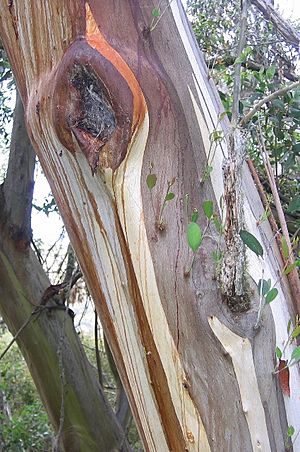Snow gum facts for kids
Quick facts for kids Snow gum |
|
|---|---|
 |
|
| Eucalyptus pauciflora near Thredbo | |
| Scientific classification | |
| Genus: |
Eucalyptus
|
| Species: |
pauciflora
|
| Synonyms | |
The Eucalyptus pauciflora, often called Snow Gum, Cabbage Gum, or White Sally, is a unique tree from eastern Australia. It can grow as a tall tree or a smaller, bushy plant called a mallee. This tree is known for its smooth bark, long leaves, and white flowers. You can usually find Snow Gums growing in cold, high places, often above 700 meters (about 2,300 feet) in woodlands.
Contents
What Does a Snow Gum Look Like?
The Snow Gum is a tree or a mallee that usually grows to be 20 to 30 meters (about 65 to 100 feet) tall. It has a special woody swelling at its base called a lignotuber, which helps it regrow after fires.
Bark and Leaves
The bark of the Snow Gum is very smooth. It can be white, grey, or yellow and peels off in long strips. Sometimes, you might even see wiggly lines on the bark made by insects!
Young Snow Gum plants have dull, bluish-green leaves that are shaped like a spear or an egg. These leaves are about 4 to 17 centimeters (1.5 to 6.5 inches) long. As the tree gets older, its leaves become shiny green on both sides. They are shaped like a spear or are slightly curved, growing up to 20 centimeters (8 inches) long.
Flowers and Fruit
Snow Gum flowers grow in groups of 7 to 15, or sometimes even more. These groups are found where the leaves meet the stem. Each flower bud is oval-shaped and has a cone-shaped cap.
The flowers are white and usually bloom from October to February. After the flowers, the tree produces woody fruits. These fruits are shaped like a cup, cone, or half-sphere and are about 5 to 11 millimeters (0.2 to 0.4 inches) long and wide.
How Snow Gums Got Their Name
The scientific name for the Snow Gum, Eucalyptus pauciflora, was first written down in 1827. The word pauciflora comes from Latin and means "few-flowered." However, this name is a bit misleading because Snow Gums actually have many flowers! It's thought that the first plant specimen collected might have lost most of its buds during its journey.
Different Types of Snow Gums
There are six different types, or subspecies, of Snow Gum. They are found in different parts of Australia:
- Eucalyptus pauciflora subsp. acerina is found in Victoria.
- Eucalyptus pauciflora subsp. debeuzevillei grows in Victoria, New South Wales, and the Australian Capital Territory.
- Eucalyptus pauciflora subsp. hedraia is also found in Victoria.
- Eucalyptus pauciflora subsp. niphophila grows in New South Wales, the Australian Capital Territory, and Victoria.
- Eucalyptus pauciflora subsp. parvifructa is found in Victoria.
- The most common type, Eucalyptus pauciflora subsp. pauciflora, grows in Queensland, New South Wales, the Australian Capital Territory, Victoria, South Australia, and Tasmania.
Where Snow Gums Grow
Snow Gums live in woodlands across the mountain ranges and high plateaus of eastern Australia. They prefer flat, cold areas above 700 meters (about 2,300 feet) in altitude. You can find them from the far southeast of Queensland, through New South Wales, the Australian Capital Territory, and Victoria, all the way to South Australia and Tasmania.
In Tasmania, Snow Gums can even mix with other eucalyptus species, like the Eucalyptus coccifera and Eucalyptus amygdalina, to create hybrid trees.
How Snow Gums Survive and Grow
Snow Gums are some of the toughest eucalyptus trees. They can handle the very cold winter temperatures of the Australian Alps. These trees can regrow from their seeds, from special shoots under their bark (called epicormic shoots), and from their lignotubers.
They are the most cold-tolerant type of eucalyptus. One subspecies, E. pauciflora subsp. niphophila, can even survive temperatures as low as -23°C (-9°F) and frosts all year round! Because they are so tough, Snow Gums have even been planted in Norway.
Snow Gums and Snowpack
In high mountains where Snow Gums grow, especially above 1500 meters (about 4,900 feet), these trees help the snowpack. They make the snow pile up more and melt slower. This is super important for the water supply in southeast Australia.
When bushfires hit Snow Gum forests, it changes how the snowpack works. The snow melts faster, and more water evaporates, meaning less water flows into rivers and streams. The big bushfires in 2019-2020 affected a large area of Snow Gum forests. This could lead to a big reduction in the amount of water from melting snow, which is used by nature and people.
Growing Snow Gums in Gardens
Some types of Snow Gums are popular for planting in gardens, especially in places like the UK. Eucalyptus pauciflora subsp. niphophila and Eucalyptus pauciflora subsp. debeuzevillei have even won awards for being great garden plants from the Royal Horticultural Society.
Images for kids
-
A Snow Gum at Perisher in New South Wales
See also
 In Spanish: Eucalipto de nieve para niños
In Spanish: Eucalipto de nieve para niños







